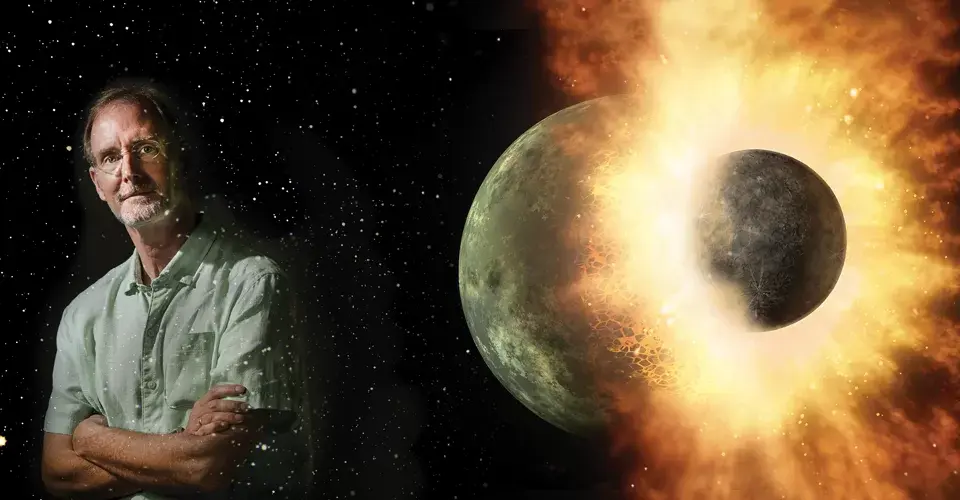Moon Mystery
Scientists Find Evidence Cosmic Collision Formed Moon
by Chris Carroll | photo by John T. Consoli | planetary collision image courtesy of nasa/jpl-caltechThrough the ages, it has inspired poets and painters while inflaming lunatics and lovers. And since the 19th century, the moon has also puzzled scientists.
They’ve struggled to explain exactly how Earth obtained its nearly planet-size satellite, bigger than Pluto and not much smaller than Mercury. Because of the moon’s mass—no other solar system planet has a larger one, relatively speaking—its physical influence is profound, affecting tides, geology, the Earth’s tilt and even the rise of life.
One early hypothesis on the moon’s origin came from Charles Darwin’s son George, who in 1878 suggested the young planet once spun so rapidly that with the help of solar gravity, it threw enough material into orbit to form the moon.
Later astronomers offered other explanations: The moon formed elsewhere but was captured by Earth’s gravity while wandering nearby, or the Earth and moon coalesced in tandem out of dust and debris filling the early solar system.
The problem was that none of them actually made much sense or followed the laws of physics—until a new theory arose in the 1970s.
Called “giant impact,” it proposes that a Mars-size planet called Theia careered through the violent early solar system 4.5 billion years ago and bashed into the Earth, partially melding the two planets and throwing out debris that gravity shaped into the moon.
While this explanation seemed more plausible, it raised new questions. The biggest was why terrestrial and lunar rocks showed no obvious chemical evidence that a wayward planet had ever hit Earth, says Richard Walker, a Maryland geology professor.
For cosmochemists like Walker, different forms of elements—or isotopes—are the equivalent of DNA for biologists.
“One of the problems with this model to explain moon formation is the genetic similarity between the Earth and the moon,” he says. A planet from elsewhere in the solar system would be expected to carry different isotopic signatures, but “they are virtually identical.”
A paper published in Nature earlier this year by Walker, UMD senior research scientist Igor S. Puchtel and postdoctoral researcher Mathieu Touboul provides groundbreaking evidence reconciling the giant impact theory with the vexing similarity.
What they found confirms the giant impact, and suggests a collision so violent that it not only resulted in the moon, but left a new version of the Earth in its wake.
After the impact, hellish conditions prevailed on Earth, which was encircled with a fiery “flying magma ocean” that may have persisted for thousands of years. Such conditions ensured a thorough mixing of material from Earth and Theia and a heat-induced “equilibration” of elements. This homogenization would explain why the two bodies ended up with virtually identical isotopic signatures.
To show that the Earth and moon formed at the same time, they tested for the “fingerprints” of asteroids that hit both bodies after the giant impact. Because the Earth is a larger body, physics suggests it will attract more asteroids than the moon—and as a result, the difference in the concentration of a specific isotope of the element tungsten should vary by 20 parts per million between Earth rocks and moon rocks.
Their tests confirmed the hypothesis was spot-on, providing powerful experimental evidence for the giant impact.
“I think for the first time in my life, I was correct in making a prediction,” Walker jokes.
It’s an important result but a narrow one, and it doesn’t close the book on the matter. Physicists still must explain important details, Walker says, such as how much of Theia’s mass sank into the Earth, and how much was ejected into space. As for the flying magma ocean, while interesting to envision—“we just don’t know how the physics of that would work,” he says.
Maryland astronomy Professor Jessica Sunshine, an expert on the conditions that prevailed in the early solar system, says Walker and his co-authors pushed experimental technique to new levels in the study. Earlier attempts at such studies were stymied by the imprecision of measurements, but the margin of error is now tiny, she says.
“That’s a testament to better instrumentation, better techniques, and the fact we’re really asking fine questions now,” she says.
0 Comments
Leave a Reply
* indicates a required field

